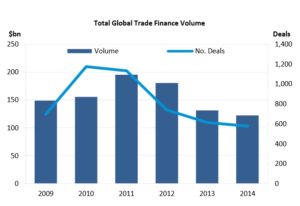Doing business means taking risks. Doing global business increases those risks: Will the buyer pay for the goods, and will he pay on time? Will the goods I ordered be delivered on the agreed terms? Is there a risk of political instability disrupting the trade relations? How will I finance my planned purchases and avoid liquidity shortages? Trade finance refers to banking services which facilitate the movement of goods and cover several types of risks associated with international trade.

Bank-intermediated financing of trade has been the preferred instrument to offset these risks for years, thus making trade finance an important tool of international trade. It usually includes such activities as leasing, letters of credit, bank guarantees, factoring, insurance etc. According to the WTO (World Trade Organization) Some 80 to 90 percent of world trade relies on trade finance (letters of credit and guarantees), mostly of a short-term nature. Some of the main users of these services are machinery importers and exporters.
Increasing Volumes
Global trade of goods has been growing at double-digit rates since the early 2000s, outpacing the growth in world Gross Domestic Product. The volume of trade finance transactions has fluctuated between 150 – 200 billion USD during the recent years. Large global banks continue to play an important role accounting for a quarter to a third of global trade finance.

Trade Finance – How It Works
The most popular and widely used trade finance product is the Letter of Credit (LC). The main benefit of using a LC is to insure the buyer that the payment will be executed only after the quality/delivery terms have been respected by the seller as agreed upon between the parties. A Letter of Credit covers the following risks:
- Can the buyer pay for the shipped goods?
- Will the goods be of the same quality/quantity as agreed upon?
- Will the goods be shipped on the terms agreed upon?
- Will the seller ship the goods at all?
The key elements of a LC are:
- Amount of money: Is the amount to be paid based on the sales agreement between the parties
- Date and place of expiry of the LC: is the last date when the documents must be presented to the bank at the specified location of the bank.
- Last date of delivery: the last date on which the goods must be shipped according to the underlying contract.
- List of documents to be presented: specified the type and nr of copies, generally includes (original invoice, transport docs, packing list etc)
It is important to note that payment under a LC is done only after all the conditions in the LC have been met
The functioning of the LC’s is regulated by a set of rules issued by ICC (International Chamber of Commerce), Paris. These are the Uniform Customs and Practice for Documentary Credits, current version UCP 600.




Thank you for such a good passage discussed. I really have a great time understanding it.